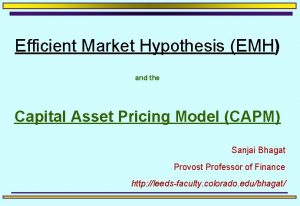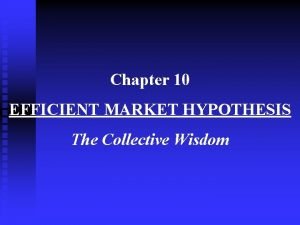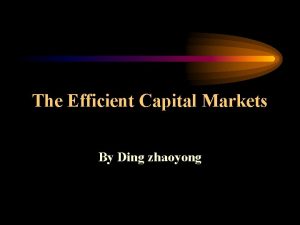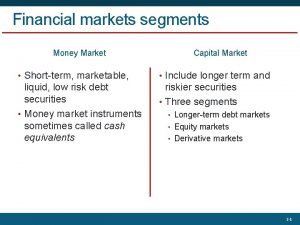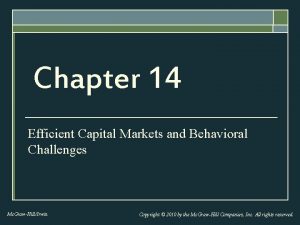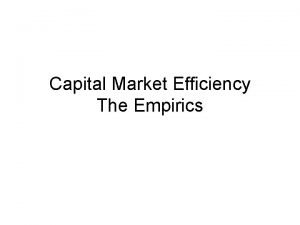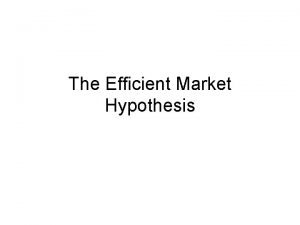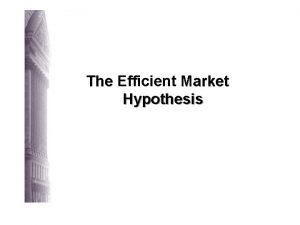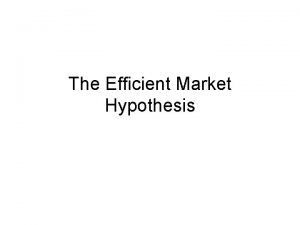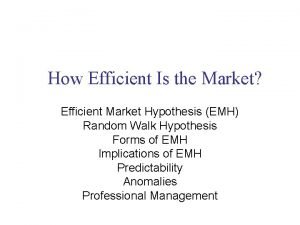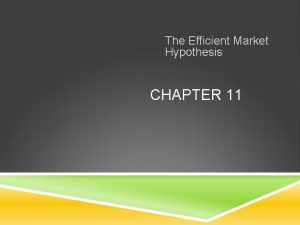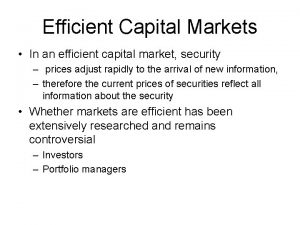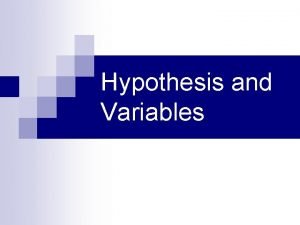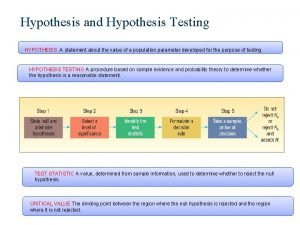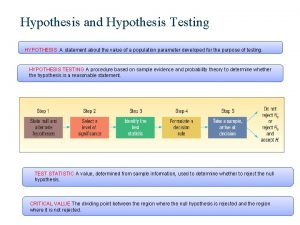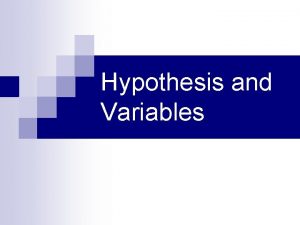Efficient Market Hypothesis A Description of Efficient Capital


































- Slides: 34

Efficient Market Hypothesis

A Description of Efficient Capital Markets An efficient capital market is one in which stock prices fully reflect available information. The EMH has implications for investors and firms. Since information is reflected in security prices quickly, knowing information when it is released does an investor no good. Firms should expect to receive the fair value for securities that they sell. Firms cannot profit from fooling investors in an efficient market.

Reaction of Stock Price to New Information in Efficient and Inefficient Markets Stock Price Overreaction to “good news” with reversion Delayed response to “good news” Efficient market response to “good news” -30 -20 -10 0 +10 +20 +30 Days before (-) and after (+) announcement

Reaction of Stock Price to New Information in Efficient and Inefficient Markets Stock Price Efficient market response to “bad news” -30 -20 -10 0 Overreaction to “bad news” with reversion Delayed response to “bad news” +10 +20 +30 Days before (-) and after (+) announcement

The Different Types of Efficiency Weak Form Semi-Strong Form Security prices reflect all information found in past prices and volume. Security prices information. reflect all publicly available Strong Form Security prices reflect all information—public and private.

Weak Form Market Efficiency Security prices reflect all information found in past prices and volume. If the weak form of market efficiency holds, then technical analysis is of no value. Often weak-form efficiency is represented as Pt = Pt-1 + Expected return + random error t Since stock prices only respond to new information, which by definition arrives randomly, stock prices are said to follow a random walk.

Semi-Strong Form Market Efficiency Security Prices reflect available information. all publicly Publicly available information includes: Historical price and volume information Published accounting statements. Information found in annual reports.

Strong Form Market Efficiency Security Prices reflect all information—public and private. Strong form efficiency incorporates weak and semi-strong form efficiency. Strong form efficiency says that anything pertinent to the stock and known to at least one investor is already incorporated into the security’s price.

Relationship among Three Different Information Sets

Criticism of EMH Imperfections observed in the financial markets can be attributed to a combination of cognitive biases such as overconfidence, overreaction, representative bias, information bias, and various other predictable human errors in reasoning and information processing

MAKING RELEVANT COMPARISONS PERFORMANCE should be evaluated on the basis of a relative and not an absolute basis this is done by use of a benchmark portfolio BENCHMARK PORTFOLIO should be relevant and feasible reflects objectives of the fund reflects return as well as risk 11

THE USE OF MARKET INDICES are used to indicate performance but depend upon the securities used to calculate them the calculation weighting measures 12

THE USE OF MARKET INDICES Three Calculation Weighting Methods: price weighting sum prices and divided by a constant to determine average price EXAMPLE: THE DOW JONES INDICES 13

THE USE OF MARKET INDICES Three Calculation Weighting Methods: value weighting (capitalization method) price times number of shares outstanding is summed divide by beginning value of index EXAMPLE: S&P 500 WILSHIRE 5000 RUSSELL 1000 14

THE USE OF MARKET INDICES Three Calculation Weighting Methods: equal weighting multiply the level of the index on the previous day by the arithmetic mean of the daily price relatives EXAMPLE: VALUE LINE COMPOSITE 15

ARITHMETIC V. GEOMETRIC AVERAGES GEOMETRIC MEAN FRAMEWORK GM = ( HPR)1/N - 1 where = the summation of the product of HPR= the holding period returns n= the number of periods 16

ARITHMETIC V. GEOMETRIC AVERAGES GEOMETRIC MEAN FRAMEWORK measures past performance well represents exactly the constant rate of return needed to earn in each year to match some historical performance 17

ARITHMETIC V. GEOMETRIC AVERAGES ARITHMETIC MEAN FRAMEWORK provides a good indication of the expected rate of return for an investment during a future individual year it is biased upward if you attempt to measure an asset’s long-run performance 18

RISK-ADJUSTED MEASURES OF PERFORMANCE THE REWARD TO VOLATILITY RATIO (TREYNOR MEASURE) There are two components of risk associated with market fluctuations risk associated with the stock Characteristic Line (ex post security line) defines the relationship between historical portfolio returns and the market portfolio 19

TREYNOR MEASURE Formula where arp = the average portfolio return arf = the average risk free rate p = the slope of the characteristic line during the time period 20

TREYNOR MEASURE CHARACTERISTIC LINE slope of CL measures the relative volatility of portfolio returns in relation to returns for the aggregate market, i. e. the portfolio’s beta the higher the slope, the more sensitive is the portfolio to the market 21

TREYNOR MEASURE THE CHARACTERISTIC LINE arp SML p 22

THE SHARPE RATIO THE REWARD TO VARIABILITY (SHARPE RATIO) measure of risk-adjusted performance that uses a benchmark based on the ex-post security market line total risk is measured by p 23

THE SHARPE RATIO formula: where SR = the Sharpe ratio p = the total risk 24

THE SHARPE RATIO indicates the risk premium per unit of total risk uses the Capital Market Line in its analysis 25

THE JENSEN MEASURE OF PORTFOLIO PERFORMANCE BASED ON THE CAPM EQUATION measures the average return on the portfolio over and above that predicted by the CAPM given the portfolio’s beta and the average market return 26

THE JENSEN MEASURE OF PORTFOLIO PERFORMANCE THE JENSEN MEASURE known as the portfolio’s alpha value recall the linear regression equation y = + x + e alpha is the intercept 27

THE JENSEN MEASURE OF PORTFOLIO PERFORMANCE DERIVATION OF ALPHA Let the expectations formula in terms of realized rates of return be written subtracting RFR from both sides 28

THE JENSEN MEASURE OF PORTFOLIO PERFORMANCE DERIVATION OF ALPHA in this form an intercept value for the regression is not expected if all assets are in equilibrium in words, the risk premium earned on the jth portfolio is equal to j times a market risk premium plus a random error term 29

THE JENSEN MEASURE OF PORTFOLIO PERFORMANCE DERIVATION OF ALPHA to measure superior portfolio performance, you must allow for an intercept a superior manager has a significant and positive alpha because of constant positive random errors 30

COMPARING MEASURES OF PERFORMANCE TREYNOR V. SHARPE SR measures uses as a measure of risk while Treynor uses SR evaluates the manager on the basis of both rate of return performance as well as diversification 31

COMPARING MEASURES OF PERFORMANCE for a completely diversified portfolio SR and Treynor give identical rankings because total risk is really systematic variance any difference in ranking comes directly from a difference in diversification 32

CRITICISM OF RISK-ADJUSTED PERFORMANCE MEASURES Use of a market surrogate Roll: criticized any measure that attempted to model the market portfolio with a surrogate such as the S&P 500 it is almost impossible to form a portfolio whose returns replicate those over time making slight changes in the surrogate may completely change performance rankings 33

CRITICISM OF RISK-ADJUSTED PERFORMANCE MEASURES measuring the risk free rate using T-bills gives too low of a return making it easier for a portfolio to show superior performance borrowing a T-bill rate is unrealistically low and produces too high a rate of return making it more difficult to show superior performance 34
 Evidence supporting efficient market hypothesis
Evidence supporting efficient market hypothesis Efficient markets theory
Efficient markets theory Efficient market hypothesis
Efficient market hypothesis Efficient market hypothesis.
Efficient market hypothesis. The efficient market hypothesis suggests that _______.
The efficient market hypothesis suggests that _______. Cost efficient capital market
Cost efficient capital market Efficient elements alternative
Efficient elements alternative Informationally efficient
Informationally efficient Capital allocation line vs capital market line
Capital allocation line vs capital market line Money market capital market
Money market capital market Money market and its functions
Money market and its functions Productively efficient vs allocatively efficient
Productively efficient vs allocatively efficient Allocative efficiency
Allocative efficiency Productively efficient vs allocatively efficient
Productively efficient vs allocatively efficient Allocative efficiency vs productive efficiency
Allocative efficiency vs productive efficiency Allocative efficiency vs productive efficiency
Allocative efficiency vs productive efficiency Market leader challenger follower nicher examples
Market leader challenger follower nicher examples Marketing segmentation targeting positioning
Marketing segmentation targeting positioning Efficient capital markets and behavioral challenges
Efficient capital markets and behavioral challenges Efficient capital allocation
Efficient capital allocation Efficient capital markets ii
Efficient capital markets ii Define null hypothesis
Define null hypothesis Null and alternative hypothesis statistics
Null and alternative hypothesis statistics Null hypothesis and alternative hypothesis examples
Null hypothesis and alternative hypothesis examples Weakness of protoplanet hypothesis
Weakness of protoplanet hypothesis Characteristics of an efficient market
Characteristics of an efficient market Working capital management introduction
Working capital management introduction Difference between capital reserve and reserve capital
Difference between capital reserve and reserve capital Multinational capital structure
Multinational capital structure Difference between capital reserve and reserve capital
Difference between capital reserve and reserve capital Regulatory capital vs economic capital
Regulatory capital vs economic capital Regulatory capital vs economic capital
Regulatory capital vs economic capital Constant vs variable capital
Constant vs variable capital Multinational cost of capital and capital structure
Multinational cost of capital and capital structure Fractal market hypothesis
Fractal market hypothesis


